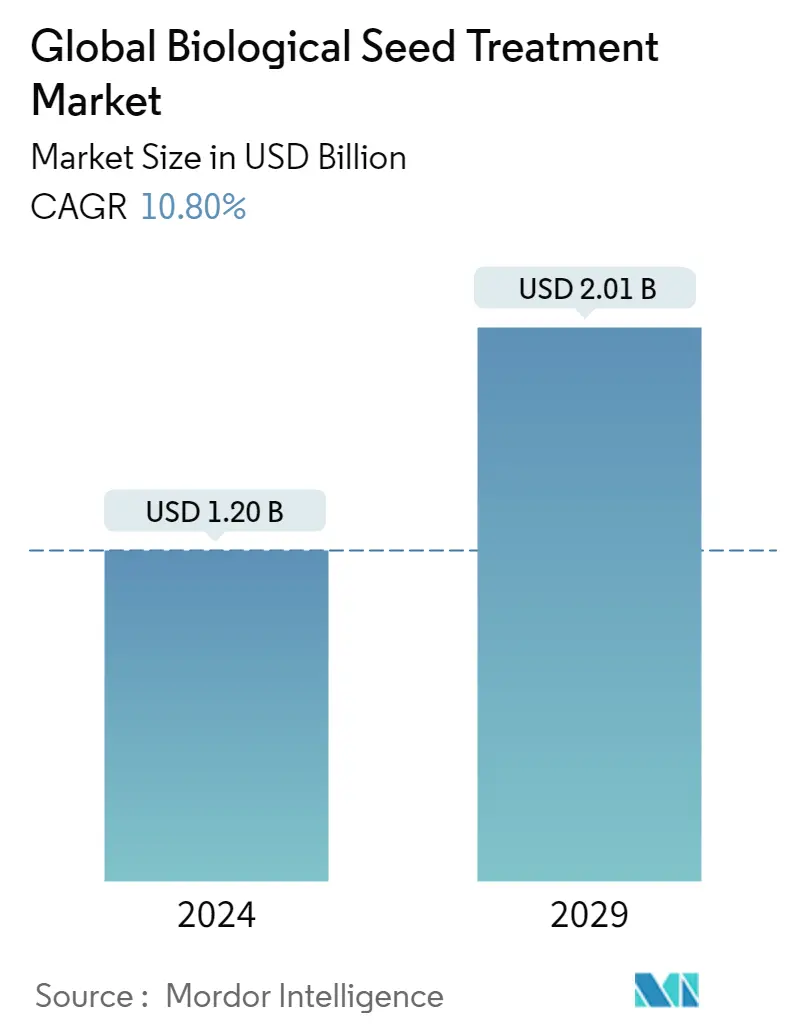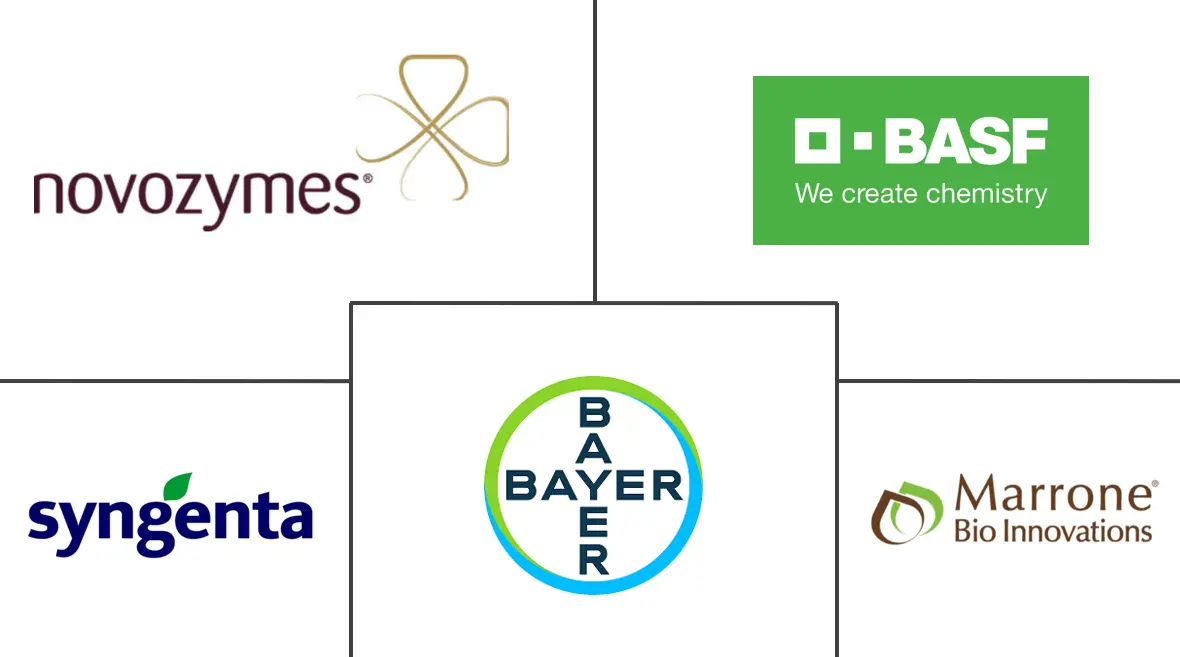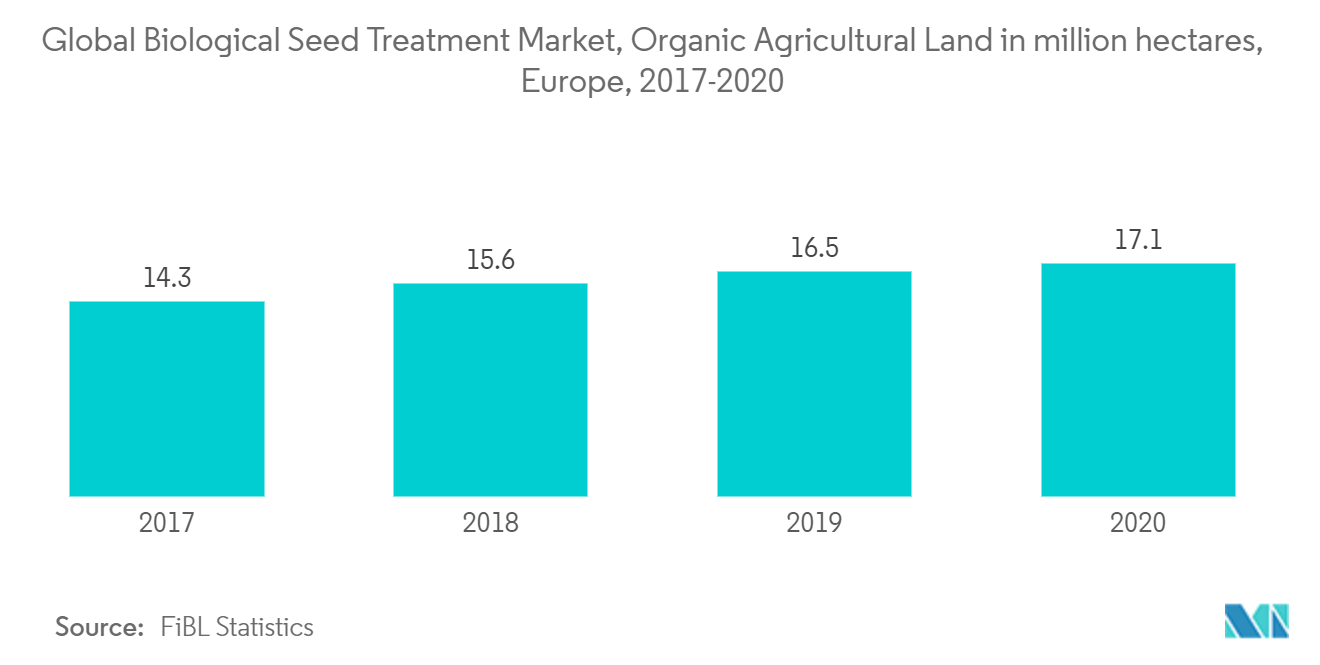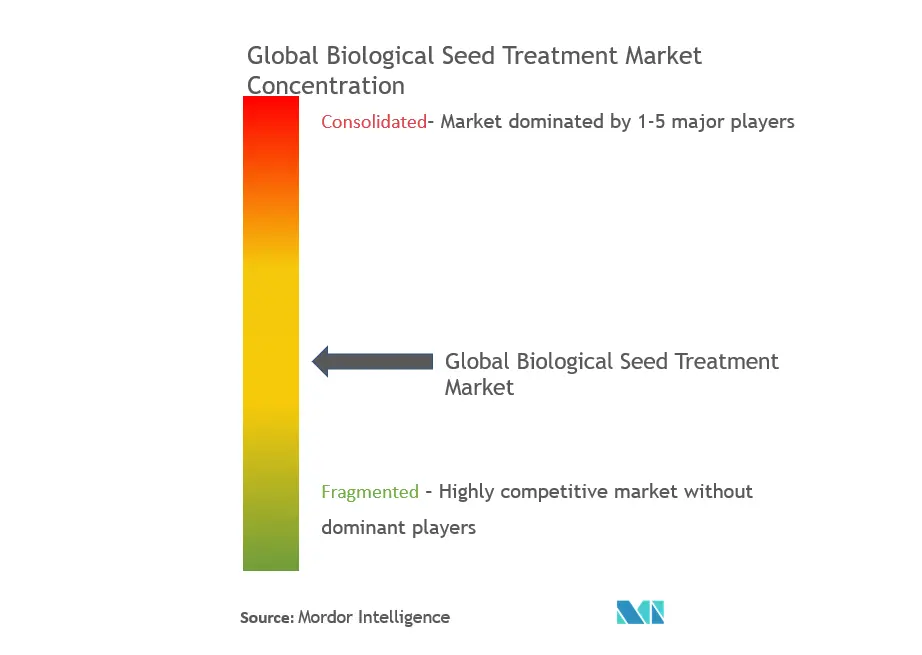Biological Seed Treatment Market Size

| Study Period | 2019 - 2029 |
| Market Size (2024) | USD 1.20 Billion |
| Market Size (2029) | USD 2.01 Billion |
| CAGR (2024 - 2029) | 10.80 % |
| Fastest Growing Market | Asia-Pacific |
| Largest Market | Europe |
Major Players
*Disclaimer: Major Players sorted in no particular order |
Biological Seed Treatment Market Analysis
The Global Biological Seed Treatment Market size is estimated at USD 1.20 billion in 2024, and is expected to reach USD 2.01 billion by 2029, growing at a CAGR of 10.80% during the forecast period (2024-2029).
COVID-19 caused challenges with respect to a temporary pause in manufacturing and supply chain disruption. Nevertheless, post the lockdown in the first few weeks, manufacturing action was allowed for essential goods with agrochemicals, including seed treatment pesticides classified under essential goods in many countries. Therefore, the impact of COVID-19 on the market studied is anticipated to be short-term. Due to panic buying by farmers, agrochemical firms have had double-digit profits compared to the previous year.
The increasing use of natural treatment methods is witnessed as an environment-friendly option for treating seeds. The increasing use of bio-priming techniques for improved productivity, increasing trend of organic farming, and players investing more in R&D activities to design biological products are driving the global market for biological seed treatment. Nevertheless, government regulatory barriers, high biological seed treatment costs, and low availability are hampering the agriculture enzyme market. Based on function, the global market has broadly been segmented into seed protection and seed enhancement. Biological seed treatments aimed at seed protection deliver targeted control of certain pests and fungal diseases during the early seedling stage.
Additionally, biological seed treatments are used on multiple crops, like grains and cereal, oil seeds, and vegetables, to control a variety of pests. The expanding agricultural practices and requirement for high-quality agricultural produce are factors that are projected to drive the biological seed treatment market growth in this region. Further, the government policies adopted by developed countries for the ban on key active ingredients are the major factors promoting the growth of this market in the Europe region. Hence, the increased adoption of environment-friendly options, the trend of organic farming, and a favorable regulatory environment are anticipated to drive the growth of the market studied during the forecast period.
Biological Seed Treatment Market Trends
This section covers the major market trends shaping the Seed Treatment Market according to our research experts:
Rising Trend of Organic Farming
One of the key factors enhancing the biological seed treatment market growth includes the rising trend of organic farming. Organic agriculture is practiced in 187 countries, and 72.3 million hectares of agricultural land were managed organically by at least 3.1 million farmers by the Research Institute of Organic Agriculture (FiBL) in 2019. Over the past few years, the area under organic farming has significantly increased across the world and was recorded at 74.9 million hectares in 2020, up from 69.5 million hectares in 2017. In 2019, the regions with the leading organic agricultural land areas are Oceania (35.9 million hectares, which is half the world's organic agricultural land) and Europe (16.5 million hectares, 23%). Latin America has 8.3 million hectares (11%), followed by Asia (5.9 million hectares, 8%), North America (3.6 million hectares, 5%), and Africa (2 million hectares, 3%). On a global scale, the organic sector continued to develop rapidly.
Due to COVID-19, consumer awareness of local, safe, and organic food increased, with many countries reporting increasing sales of organic products. However, the demand for organic products is thriving, not only due to a rise in health-conscious consumers but also the growing incomes and improved farming practices that make organic crops more robust. Consequently, the increasing demand for organic food has increased the area under organic farming across the world. In addition, the government is emphasizing the use of biological control methods for disease management.
The proliferation of organic agricultural practices has driven the adoption of biological seed treatment, especially among government-controlled farming communities. Farmers demand an early evaluation of field performance to understand the treatment specification of their crop profile. Hence, the rising organic farming practices with the growing awareness among consumers over health, environmental, quality, and safety, coupled with favorable government policies, is anticipated to boost the biofertilizers market at a phenomenal rate in the forecast period.

Higher Consumption of Biological Seed Treatment in Europe
The increasing insect pest attacks, need for better crop productivity, technological advancements by major players, and increasing incomes with the use of biological seed treatment techniques are leading to the growth of the European region in the market during the forecast period. According to the LIVESEED Project Spain 2020, the rising demand for non-GMO or organic seeds for organic export produces (e.g., peppers in Almeria and Murcia) to offer a product that guarantees export demand and high crop yield enhances the usage of biological seed treatment with bio fungicides, bio nematicides, and biopesticides to promote domestic varieties globally, is further boosting the demand for the market studied during the forecast period.
Loose smut is one of the prominent diseases affecting the cereal crops in the United Kingdom. The disease is most prominent in barley and rare in wheat. The increased concern to prevent the fungal attack of this disease, with the use of biologically treated seeds by Bacillus species, is leading to the growth of the market studied in the coming years. In addition, France introduced a scheme called 'Ecophyto 2018', which aimed at reducing 50% of the synthetic chemical consumption by 2018, which has pushed the demand for bio-based agricultural inputs within the market. German research institutes have been extensively working on advancing biological seed treatment solutions to provide sustainable solutions. Fraunhofer Institute for Organic Electronics launched an electron treatment of seeds, a modern, environmentally friendly method that works without chemical ingredients, and won a DLG award. It was described by the state entity Biologische Bundesanstalt as an alternative method for chemical dressing.

Biological Seed Treatment Industry Overview
The global biological seed treatment market is moderately consolidated, with major players such as, Syngenta, Bayer Crop Science, BASF, Novozymes, and MarroneBio Innovations in the market studied. As per the key developments observed during the review period, product launches are the most adopted strategies by dominant players in the market. Major players in the market studied are increasing their product portfolio and expanding their business to maintain their position in the market by launching innovative products.
Biological Seed Treatment Market Leaders
-
Syngenta AG
-
Bayer CropScience Limited
-
BASF SE
-
Novozymes
-
Marrone Bio Innovations
*Disclaimer: Major Players sorted in no particular order

Biological Seed Treatment Market News
in September 2021, Novozymes launched five powerful biological solutions that enable farmers to improve yield and fertility, increase the application of biocontrol while expanding the product portfolio, and strengthen their base in the United States.
In April 2021, Syngenta introduced Draco seed treatment product in Canada for partial suppression of key diseases and nematodes at the critical early stages of corn and soybean germination and seedling growth.
In March 2021, BASF committed to launching at least 30 R&D projects by 2030, which will focus on sustainable agriculture innovations that complement its offerings in seeds, seed treatments, biological and chemical solutions, and digital services.
In November 2020, Bioworks launched the RootShieldPLUS+ Granules and WP, a biological fungicide for seed treatment in Canada. This formulation contains an additional active ingredient, which prevents the diseases caused by Phytophthora and Pythium.
Biological Seed Treatment Market Report - Table of Contents
1. INTRODUCTION
- 1.1 Study Assumption and Market Definition
- 1.2 Scope of the Study
2. RESEARCH METHODOLOGY
3. EXECUTIVE SUMMARY
4. MARKET DYNAMICS
- 4.1 Market Overview
- 4.2 Market Drivers
- 4.3 Market Restraints
-
4.4 Porter's Five Forces Analysis
- 4.4.1 Bargaining Power of Suppliers
- 4.4.2 Bargaining Power of Buyers
- 4.4.3 Threat of New Entrants
- 4.4.4 Threat of Substitute Products
- 4.4.5 Intensity of Competitive Rivalry
5. MARKET SEGMENTATION
-
5.1 Function
- 5.1.1 Seed Protection
- 5.1.2 Seed Enhancement
- 5.1.3 Other Functions
-
5.2 Crop Type
- 5.2.1 Grains and Cereal
- 5.2.2 Oil Seeds
- 5.2.3 Vegetables
- 5.2.4 Other Crop Types
-
5.3 Geography
- 5.3.1 North America
- 5.3.1.1 United States
- 5.3.1.2 Canada
- 5.3.1.3 Mexico
- 5.3.1.4 Rest of North America
- 5.3.2 Europe
- 5.3.2.1 Spain
- 5.3.2.2 United Kingdom
- 5.3.2.3 France
- 5.3.2.4 Germany
- 5.3.2.5 Russia
- 5.3.2.6 Italy
- 5.3.2.7 Rest of Europe
- 5.3.3 Asia-Pacific
- 5.3.3.1 China
- 5.3.3.2 Japan
- 5.3.3.3 India
- 5.3.3.4 Thailand
- 5.3.3.5 Vietnam
- 5.3.3.6 Australia
- 5.3.3.7 Rest of Asia-Pacific
- 5.3.4 South America
- 5.3.4.1 Brazil
- 5.3.4.2 Argentina
- 5.3.4.3 Rest of South America
- 5.3.5 Middle East and Africa
6. COMPETITIVE LANDSCAPE
- 6.1 Most Adopted Strategies
- 6.2 Market Share Analysis
-
6.3 Company Profiles
- 6.3.1 BASF SE
- 6.3.2 Bayer Cropscience AG
- 6.3.3 Bioworks Inc.
- 6.3.4 Syngenta AG
- 6.3.5 Agrauxine by Lesaffre
- 6.3.6 Germains Seed Technology
- 6.3.7 Koppert Biological Systems
- 6.3.8 Novozymes
- 6.3.9 Marrone Bio Innovations
- 6.3.10 Groundwork BioAg
- *List Not Exhaustive
7. MARKET OPPORTUNITIES AND FUTURE TRENDS
8. AN ASSESSMENT OF IMAPCT OF COVID-19 OVER THE MARKET
** Subject To AvailablityBiological Seed Treatment Industry Segmentation
The Global Biological Seed Treatment Market is segmented by Function (Seed Protection, Seed Enhancement, and Other Functions), By Crop Type (Grains and Cereal, Oil Seeds, Vegetables, and Other Crop Types), By Geography (North America, Europe, Asia-Pacific, South America, and Middle East & Africa). The report offers market size and forecasts in terms of value (USD million) for all the above segments.
| Function | Seed Protection | |
| Seed Enhancement | ||
| Other Functions | ||
| Crop Type | Grains and Cereal | |
| Oil Seeds | ||
| Vegetables | ||
| Other Crop Types | ||
| Geography | North America | United States |
| Canada | ||
| Mexico | ||
| Rest of North America | ||
| Geography | Europe | Spain |
| United Kingdom | ||
| France | ||
| Germany | ||
| Russia | ||
| Italy | ||
| Rest of Europe | ||
| Geography | Asia-Pacific | China |
| Japan | ||
| India | ||
| Thailand | ||
| Vietnam | ||
| Australia | ||
| Rest of Asia-Pacific | ||
| Geography | South America | Brazil |
| Argentina | ||
| Rest of South America | ||
| Geography | Middle East and Africa |
Biological Seed Treatment Market Research FAQs
How big is the Global Biological Seed Treatment Market?
The Global Biological Seed Treatment Market size is expected to reach USD 1.20 billion in 2024 and grow at a CAGR of 10.80% to reach USD 2.01 billion by 2029.
What is the current Global Biological Seed Treatment Market size?
In 2024, the Global Biological Seed Treatment Market size is expected to reach USD 1.20 billion.
Who are the key players in Global Biological Seed Treatment Market?
Syngenta AG, Bayer CropScience Limited , BASF SE, Novozymes and Marrone Bio Innovations are the major companies operating in the Global Biological Seed Treatment Market.
Which is the fastest growing region in Global Biological Seed Treatment Market?
Asia-Pacific is estimated to grow at the highest CAGR over the forecast period (2024-2029).
Which region has the biggest share in Global Biological Seed Treatment Market?
In 2024, the Europe accounts for the largest market share in Global Biological Seed Treatment Market.
What years does this Global Biological Seed Treatment Market cover, and what was the market size in 2023?
In 2023, the Global Biological Seed Treatment Market size was estimated at USD 1.08 billion. The report covers the Global Biological Seed Treatment Market historical market size for years: 2019, 2020, 2021, 2022 and 2023. The report also forecasts the Global Biological Seed Treatment Market size for years: 2024, 2025, 2026, 2027, 2028 and 2029.
Biological Seed Treatment Industry Report
Statistics for the 2024 Biological Seed Treatment market share, size and revenue growth rate, created by Mordor Intelligence™ Industry Reports. Biological Seed Treatment analysis includes a market forecast outlook to 2029 and historical overview. Get a sample of this industry analysis as a free report PDF download.



